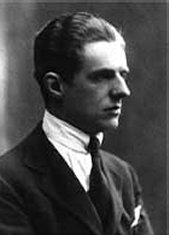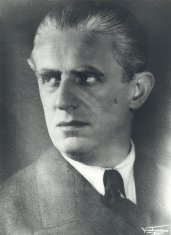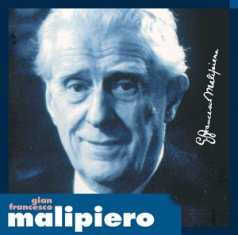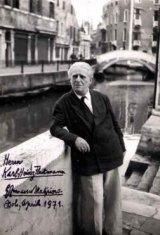|
|
Gian-Francesco Malipiero (Composer) |
|
Born: March 18, 1882 - Venice, Italy
Died: August 1, 1973 - Treviso, near Venice, Italy |
|
Gian-Francesco Malipiero was an Italian composer, musicologist, music teacher and editor. |
|
Life |
|
Born in Venice into a family of musicians of aristocratic origin, Gian-Francesco Malipiero was the grandson of the opera composer Francesco Malipiero (1824-1887) and the uncle of Riccardo Malipiero. His childhood was restless and troubled: after the break-up in 1893 of his parents’ marriage, his father Luigi, a pianist and conductor, took him to Trieste, Berlin and eventually Vienna, where the boy studied briefly at the conservatory (1898-1899). The young Malipiero and his father broke up their relationship bitterly, and in 1899 he returned to his mother’s house in Venice, where he entered the Liceo Musicale, learning counterpoint from the composer, organist and pedagogue Marco Enrico Bossi, who at first had a low opinion of him. After Marco Enrico Bossi’s move to Bologna (1902), Malipiero continued his composition studies on his own. It was then that an important new experience transformed his musical outlook: in 1902, without any external encouragement, he discovered and began to transcribe the long-forgotten early Italian music (Claudio Monteverdi, Girolamo Frescobaldi, Claudio Merulo, etc.) in the Biblioteca Marciana. By 1904, when he too moved to Bologna, his composition technique had matured sufficiently to win Marco Enrico Bossi’s approval and a diploma at that city’s Liceo Musicale.
After graduating, Gian-Francesco Malipiero became amanuensis for a while to the blind composer Antonio Smareglia, a disciple of Wagner. Later he claimed that he learnt more, especially about orchestration, from this experience than from all his formal studies. In 1905 Gian Francesco Malipiero returned to Venice, but from 1906 and 1909 was often in Berlin, following Max Bruch classes. He gained nothing significant from those classes. Later, in 1913, Malipiero moved to Paris, where he became acquainted with compositions by Ravel, De Falla, Arnold Schoenberg, Alban Berg. He discovered the music of Debussy, and his enthusiasm, albeit short-lived, for Strauss’s Elektra, the première of which he attended. He met in Paris the composer Gabriele d'Annunzio. Another landmark in his Paris experience: was that he formed a lasting friendship with Alfredo Casella, and the first performance of Igor Stravinsky's Le Sacre du Printemps, which he attended on Alfredo Casella’s suggestion, woke him, as he later put it, ‘from a long and dangerous lethargy’. As a result he soon decided to suppress nearly all his compositions written up to that time, with the exception of Impressioni dal vero (1910-1911), although contrary to what he consistently gave the world to understand, he did not destroy most of the manuscripts. (The surviving juvenilia were deposited after the composer’s death at the Fondazione Giorgio Cini, Venice.) Meanwhile, however, he had caused ill-feeling in many quarters, and won sudden notoriety, by entering five works, each under a different pseudonym, for a competition organized in 1912-1913 by the Accademia di S Cecilia, Rome, thus winning four of the five prizes.
Though again based in Venice after his return from Bologna in 1905, Gian-Francesco Malipiero spent more and more time from 1910 onwards in the little Veneto hill town of Asolo. But before he could settle there permanently the Retreat of Caporetto forced him and his family to flee, in November 1917, to Rome, and he arrived there with shattered nerves. He later wrote of this tormented time: ‘In 1914 the war disrupted my whole life, which remained, until 1920, a perennial tragedy. The works of these years perhaps reflect my agitation; however, I consider that if I have created something new in my art (formally and stylistically) it happened precisely in this period’. He remained in Rome until 1921 (spending the summer months in Capri) and was associated, while there, with Alfredo Casella’s Società Italiana di Musica Moderna. The two again collaborated, in 1923, in founding together with Gabriele D'Annunzio the Corporazione delle Nuove Musiche; but Malipiero was less practical and extroverted than Alfredo Casella, and played a less central part in the campaign to modernize Italian music. Even smaller was his role in the fascist regime’s reorganization of musical life, though he actively sought, and for a while appears to have enjoyed, the personal favour of Mussolini, with whom he may have had as many as three personal audiences. That favour was curtailed abruptly in 1934 by the Duce’s condemnation of Malipiero’s opera La favola del figlio cambiato, a condemnation seemingly directed more at Pirandello’s libretto than at the music. Malipiero sought to appease Mussolini by dedicating to him his next opera Giulio Cesare, but the dictator, now preoccupied with his Abyssinian campaign, refused the composer’s next request for an audience.
In 1921 Gian-Francesco Malipiero was appointed professor of composition at the Parma Conservatory, but he resigned three years later (1924), by which time he had bought (late in 1922) the house in Asolo that remained his home until his death. Having thus stabilized his life as never before, he embarked, in 1926, on his edition of all Monteverdi’s works . The fruits of these labours, completed in 1942, for which he would become best known, have been justly criticized, but their importance as a major step in Monteverdi studies is unquestionable.
In 1932 Gian-Francesco Malipiero again became a professor of composition, this time at the Venice Liceo Musicale (Conservatory from 1940), which he directed from 1939 to 1952. Among others, he taught Luigi Nono and his own nephew Riccardo Malipiero. After his retirement from the conservatory, he continued to teach privately and to preside over the Istituto Italiano Antonio Vivaldi, editing many volumes in the series of Antonio Vivaldi’s complete instrumental works. But these activities, like their equivalents in earlier periods, always remained secondary to his irrepressible urge to compose, which continued unabated right up to 1971. |
|
Gian Francesco Malipiero was an Italian composer, musicologist, music teacher and editor. |
|
Music |
|
Gian-Francesco Malipiero had an ambivalent attitude towards the musical tradition dominated by Austro-German composers, and instead insisted on the rediscovery of pre-19th century Italian music.
His orchestral works include seventeen compositions he called symphonies, of which however only eleven are numbered. The first was composed in 1933, when Malipiero was already over fifty years old. Prior to that, Malipiero had written several important orchestral pieces but avoided the word "sinfonia" (symphony) almost completely. This was due to his rejection of the Austro-German symphonic tradition. The only exceptions to that are the three compositions Sinfonia degli eroi (1905), Sinfonia del mare (1906) and Sinfonie del silenzio e della morte (1909-1910). In such early works, the label "symphony" should not, however, be interpreted as indicating works in the Beethovenian or Brahmsian symphonic style, but more as symphonic poems.
When asked in the mid-1950s by the British encyclopedia The World of Music, Gian Francesco Malipiero listed as his most important compositions the following pieces:
- Pause del Silenzio for the orchestra, composed in 1917
- Rispetti e Strambotti for the chamber music, composed in 1920
- L'Orfeide for the stage, composed between 1918 and 1922, and first performed in 1924
- La P, a mystery play composed in 1935
- his nine symphonies, composed between 1933 and 1955 (he would compose additional symphonies in the years after this list was made)
He regarded Impressioni dal vero, for orchestra, as his earliest work of lasting importance.
Even if Malipiero rarely, if ever, dealt with dodecaphony, he was strongly critical of sonata form and, in general, of standard thematic development in composition. He declared:
“As a matter of fact I rejected the easy game of thematic development because I was fed up with it and it bored me to death. Once one finds a theme, turns it around, dismembers it and blows it up, it is not very difficult to assemble the first movement of a symphony (or a sonata) that will be amusing for amateurs and also satisfy the lack of sensitivity of the knowledgeable.”
Malipiero's musical language is characterized by an extreme formal freedom; he always renounced the academic discipline of variation, preferring the more anarchic expression of song, and he avoided falling into program music descriptivism. Until the first half of the 1950’s, Malipiero remained tied to diatonism, maintaining a connection with the pre-19th century Italian instrumental music and Gregorian chant, moving then slowly to increasingly eerie and tense territories that put him closer to total chromaticism. He did not abandon his previous style but he reinvented it. In his latest pages, it is possible to recognize suggestions from his pupils Luigi Nono and Bruno Maderna.
His compositions are based on free, non-thematic passages as much as in thematic composition, and seldom do movements end in the keys in which they started.
When Malipiero approached the symphony, he did not do so in the so-called post-Beethovenian sense, and for this reason authors rather described his works as "sinfonias" (the Italian term), to emphasize Malipiero's fundamentally Italian, anti-Germanic approach. He remarked:
“The Italian symphony is a free kind of poem in several parts which follow one another capriciously, obeying only those mysterious laws that instinct recognizes”
As Ernest Ansermet once declared, "these symphonies are not thematic but 'motivic': that is to say Malipiero uses melodic motifs like everyone else [...] they generate other motifs, they reappear, but they do not carry the musical discourse -they are, rather, carried by it". |
|
Selected works |
|
Orchestral:
Sinfonia degli eroi (1905)
Sinfonia del mare (1906)
Sinfonia del silenzio e de la morte (1909-1910)
Impressioni dal vero prima parte (1910)
Impressioni dal vero seconda parte (1915)
Pause del Silenzio (1917)
Cimarosiana (1921), five symphonic fragments from keyboard works of Cimarosa
Impressioni dal vero terza parte (1922)
Concerti (1931)
Concerto No. 1 for Piano and Orchestra (1931)
Inni (1932)
Concerto No. 1 for Violin and Orchestra (1932)
Sette Invenzioni (1933)
Sinfonia No. 1 "In quattro tempi, come le quattro stagioni" (1933)
Sinfonia No. 2 "Elegiaca" (1936)
Concerto for Cello and Orchestra (1937)
Concerto No. 2 for Piano and Orchestra (1937)
Concerto a tre for Violin, Cello, Piano and Orchestra (1938)
Sinfonia No. 3 "Delle campane" (1944-1945)
Sinfonia No. 4 "In memoriam" (1946)
Sinfonia No. 5 "Concertante in eco" (1947)
Sinfonia No. 6 "Degli archi" (1947)
Sinfonia No. 7 "Delle canzoni" (1948)
Concerto No. 3 per pianoforte e orchestra (1948)
Concerto No. 4 per pianoforte e orchestra (1950)
Sinfonia in un tempo (1950)
Sinfonia dello Zodiaco "Quattro partite: dalla primavera all'inverno" (1951)
Vivaldiana (1952)
Passacaglie (1952)
Fantasie di ogni giorno (1953)
Elegia capriccio (1953)
Fantasie concertanti (1954)
Notturno di canti e balli (1957)
Concerto No. 5 for Piano and Orchestra (1958)
Sinfonia per Antigenida (1962)
Concerto No. 2 for Violin and Orchestra (1963)
Sinfonia No. 8 "Symphonia brevis" (1964)
Concerto No. 6 for Piano and Orchestra (1964)
Sinfonia No. 9 "Dell'Ahimè" (1966)
Sinfonia No. 10 "Atropo" (1966-1967)
Concerto per flauto e orchestra (1968)
Sinfonia No. 11 "Delle cornamuse" (1969)
Gabrieliana (1971)
Omaggio a Belmonte (1971)
Operas:
L'Orfeide (1919-1922, Düsseldorf 1925), in tre parti: I "La morte delle maschere", II "Sette canzoni", III "Orfeo"
Tre commedie goldoniane (1920-1922, Darmstadt 1926): I "La bottega da caffè", II "Sior Todero Brontolon", III "Le baruffe Chiozotte"
Filomela e l'infatuato (1925, Prague 1928)
Torneo notturno (1929)
La favola del figlio cambiato (libretto di Luigi Pirandello, 1933)
Giulio Cesare (da Shakespeare (1935, Genoa 1936)
Antonio e Cleopatra (da Shakespeare, 1937, Florence 1938)
I capricci di Callot (da E.T.A. Hoffmann, 1942, Rome 1942)
L'allegra brigata (1943, Milan 1950)
Mondi celesti ed infernali (1949, Venice 1961)
Il figliuol prodigo (1952, Florence 1957)
Donna Urraca, atto unico (1954)
Venere prigioniera (1955, Florence 1957)
Il marescalco (1960, Treviso 1969)
Don Giovanni (1963, Naples)
Rappresentazione e festa di Carnasciale e della Quaresima (Opera balletto, 1961, Venice 1970)
Le metamorfosi di Bonaventura (Venice 1966)
Don Tartufo bacchettone (1966, Venice 1970)
Iscariota (1971)
Chamber:
Sonata for Cello and Piano (1907-1908)
Canto della Lontananza for Violin and Piano (1919)
String Quartet No. 1 "Rispetti e strambotti" (1920)
String Quartet No. 2 "Stornelli e ballate" (1923)
String Quartet No. 3 "Cantari alla madrigalesca" (1931)
Epodi e giambi for Violin, oboe, viola e fagotto (1932)
String Quartet No. 4 (1934)
Sonata a cinque per flauto, arpa, viola, violino e violoncello (1934)
String Quartet No. 5 "dei capricci" (1941-1950)
Sonatina for Cello and Piano (1942)
String Quartet No. 6 "l'Arca di Noé" (1947)
String Quartet No. 7 (1950)
Sonata a quattro for flute, oboe, clarinet and bassoon (1954)
Serenata mattutina per 10 strumenti (1959)
Serenata per fagotto e 10 strumenti (1961)
Macchine per 14 strumenti (1963)
String Quartet No. 8 "per Elisabetta" (1964)
Endecatode per 14 strumenti e percussione (1966)
Vocal:
Tre poesie di Angelo Poliziano (1920)
San Francesco d'Assisi, mistero per soli, coro e orchestra (1920-1921, New York 1922)
Quattro sonetti del Burchiello (1921)
Due sonetti del Berni (1922)
Le Stagioni Italiche for soprano & piano (1923, Venice 1925)
La Cena, cantata per coro e orchestra (1927, Rochester 1929)
Commiato per una voce di baritono e orchestra (1934)
La Passione, cantata for chorus & orchestra (Rome 1935)
De Profundis per una voce, viola e bass drum e pianoforte (Venise 1937)
Missa Pro Mortuis for baritone, chorus & orchestra (Rome 1938)
Quattro Vecchie Canzoni per voce e strumenti (1940, Washington 1941)
Santa Eufrosina, mistero per soprano, due baritoni, coro e orchestra (Rome 1942)
Le Sette Allegrezze d'Amore per voce e strumenti (Milan 1945)
La Terra, dalle Georgiche di Virgilio (1946)
Mondi celesti for soprano and ten instruments (1948, Capri 1949)
La Festa della Sensa for baritone, chorus & orchestra (1949-1950, Brussels 1954)
Cinque favole (1950)
Preludio e morte di Macbeth for baritone & orchestra (1958, Milan 1960)
Sette canzonette veneziane for voice & piano (1960)
Piano:
6 morceaux (6 pezzi) (1905)
Bizzarrie luminose dell'alba, del meriggio, della notte (1908)
3 danze antiche (1910)
Poemetti lunari (1909-1910)
Tre improvisi per Pianola
Impressioni (c1914)
Preludi autunnali (1914)
Poemi asolani (1916)
Barlumi (1917)
Maschere che passano (1918)
Risonanze (1918)
La siesta (1920)
A Claude Debussy (1920)
Omaggi: a un pappagallo, a un elefante, a un idiota (1920)
Cavalcate (1921)
Il tarlo (1922)
Pasqua di resurrezione (1924)
3 preludi e una fuga (1926)
Epitaffio (1931)
Prélude à une fugue imaginaire (Hommage à J.S. Bach, No. 4) (1932)
I minuetti di Ca'Tiepolo (1932)
Preludio, ritmi e canti gregoriani (1937)
Preludio e fuga (1940)
Hortus conclusus (1946)
Stradivario for 2 pianos (1955)
Dialogo no. for 2 pianos (1955)
5 studi per domani (1959)
Variazione sulla pantomima dell'"Amor brujo" di Manuel de Falla (1959)
Bianchi e neri (1964)
Ballet:
Pantea (1919)
Stradivario (1948)
El mondo novo (1951) |
|








|
|
Source: Gian Francesco MalipieWebsite; Wikipedia Website (February 2011)
Contributed by Aryeh Oron (February 2011) |
|
Gian-Francesco Malipiero : Short Biography | Bach-inspired Piano Works: Works | Recordings |
|
Links to other Sites |
|
Gian Francesco Malipiero Website
Gian Francesco Malipiero (Wikipedia)
Gian Francesco Malipiero: Biography (Answers.com)
Gian Francesco Malipiero (Classical Composers Database)
Gian Francesco Malipiero - Biography (AMG) |
Sierra Chamber Society Program Notes: Gian Francesco Malipiero (1882-1973)
Gian Francesco Malipiero - Biography (Naxos)
Gian Francesco Malipiero biography (8notes.com)
Gian Francesco Malipiero - Italian composer (Britannica) |
|
Bibliography |
|
Marcello Sorce Keller . “A Bent for Aphorisms: Some Remarks about Music and about His Own Music by Gian Francesco Malipiero”, The Music Review, XXXIX(1978), no. 3-4, 231-239 |
|
|